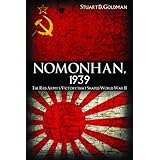As obscure WW2 battles go this might take the biscuit, but it was actually very significant. Justifying, in my view, the book's sub-title The Red Army's Victory that Shaped World War II.
It took place on the border between Soviet controlled Mongolia and Japanese controlled Manchuria. This was an area of frequent border skirmishes between the two armies including large scale actions at the Amur River and Changkufeng. The primary cause of the clash was the very aggressive leadership of the Japanese Kwantung Army. Or more accurately middle ranking elements of the leadership. What was astonishing is the way they ignored, what would be in any other army a direct order from the General Staff in Tokoyo, to break off the action. To the extent that even after being pushed back they counter attacked again. This is put down to the spirit of gekokujo (the low overcomes the high) that pervaded the Japanese military, especially the Kwantung army. The concept was used as justification for junior and mid-level military officers engaging in principled disobedience if they were motivated by moral principles.

The Nomonhan affair was based on a disputed border area. After what the Japanese regarded as an incursion by a small Mongolian force, the Kwantung army launched air attacks deep into Mongolia followed by a ground attack by a reinforced division that later expanded to become the 6th Army. The Soviets responded with what became the First Army Group commanded by none other than Zhukov. Soviet armour and artillery was vastly superior and despite fighting to almost the last man, the reinforced Japanese forces were destroyed. It was the worst Japanese defeat in modern times with some 23,000 casualties. The Soviets lost slightly more men at around 25,000.
The wider significance of the action was that Stalin felt able to focus on the West and the pact with Germany to divide Poland. It also meant he didn't have to fight a two front war unlike most other nations in WW2. Remember, it was Zukov's experienced Far Eastern army that saved Moscow and probably the Soviet Union from defeat in 1941/42. For the Japanese it encouraged a southern strategy that led to the Pacific conquests and war with the USA. Astonishingly, it was the same middle ranking officers that drove that failed strategy as well.
Overall this is an excellent study of an unusual and little covered conflict. Highly recommended.
No comments:
Post a Comment